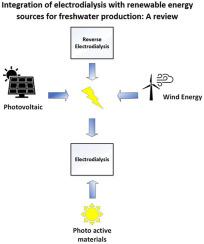Journal of Environmental Management ( IF 8.0 ) Pub Date : 2021-04-08 , DOI: 10.1016/j.jenvman.2021.112496 Namra Mir , Yusuf Bicer

|
There is an increasing demand for clean water as the population of the earth is exponentially increasing. Many countries are facing water shortage problems, which are bound to become more prevalent in upcoming years. Therefore, it is necessary to investigate sustainable methods to produce clean water for drinking, irrigation, agriculture and domestic use. Electrodialysis uses electricity and specialized membranes to separate ionic substances from water. This practice can be used for desalination and wastewater treatment. To make the process more sustainable, electrodialysis can be coupled with renewable sources of energy such as solar and wind power. Photo-electrodialysis and photovoltaic-electrodialysis are two methods commonly used to couple solar energy with the electrodialysis process. However, these processes are dependent on the availability of sunlight and wind as weather conditions and the positioning of the sun vary by time. Electrodialysis is more favourable for brackish water desalination instead of seawater desalination as it has a lower energy requirement. Desalinating brackish water (1000–5000 ppm) has an energy requirement in the range of 0.4–4 kWh/m3. This review paper summarizes the fundamental concepts of electrodialysis technology and its integration with renewable energy sources such as photo electrodialysis, photovoltaic assisted electrodialysis, reversible electrodialysis/electrodialysis and wind energy-driven electrodialysis. Some aspects that have been considered are the freshwater capacity, specific energy and costs of the hybrid systems.
中文翻译:

将电渗析与可再生能源整合以实现可持续的淡水生产:综述
随着地球人口的成倍增加,对清洁水的需求也在增加。许多国家都面临着水资源短缺的问题,这在未来几年必将越来越普遍。因此,有必要研究可持续的方法来生产用于饮用水,灌溉,农业和家庭的清洁水。电渗析利用电和专用膜将离子物质与水分离。这种做法可用于淡化和废水处理。为了使该过程更具可持续性,可以将电渗析与可再生能源(例如太阳能和风能)结合使用。光电渗析和光电渗析是将太阳能与电渗析过程耦合在一起的两种常用方法。然而,这些过程取决于天气和太阳的位置随时间变化的日光和风的可用性。电渗析比低海水淡化更适合于微咸水淡化而不是海水淡化。淡咸水(1000–5000 ppm)的能量需求在0.4–4 kWh / m的范围内3。这篇综述文章总结了电渗析技术的基本概念及其与可再生能源的整合,例如光电渗析,光伏辅助电渗析,可逆电渗析/电渗析以及风能驱动的电渗析。已经考虑的一些方面是混合系统的淡水容量,比能量和成本。











































 京公网安备 11010802027423号
京公网安备 11010802027423号